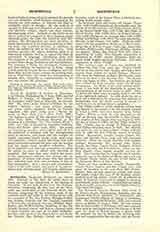

Brownsville, Vicariate Apostolic of, erected 1874. Previous to this date the entire State of Texas was under the jurisdiction of the Bishop of Galveston. It was then divided into two diocese: Galveston, comprising all that part of the State north and northwest of the Colorado River; San Antonio, comprising all the territory south of the Colorado River and north of the Nueces River, with the exception of Bee, San Patricio, Refugio, Goiad, and Aransas Counties and the Vicariate Apostolic of Brownsville comprising Cameron, Hidalgo, Starr, Zapata, and Webb Counties, bordering on the Rio Grande; Encinal, Duval, and Nueces, situated north of these counties; the part of La Salle, McMullen, and Live Oak, south of the Nueces River, and finally San Patricio, Bee, Refugio, Goliad, and Aransas Counties, north of the Nueces River, a territory comprising 22,391 square miles.
Its principal cities and towns are Laredo (Texas side), with 12,000 inhabitants; Brownsville, near the mouth of the Rio Grande, with 8,000; Corpus Christi, on the Corpus Christi Bay, with 7,000; San Diego, in Duval County, with 2,000; Alice, in Nueces County, with 1,000; Rockport, on Aransas Bay, with 1,000; Goliad and Refugio with about the same population; Beeville, in Bee County, with 2,000. There are other towns with less population, Skidmore in Bee County, Kingsville in Nueces County, Falfurrias, Benevides, Realitos, Hebbronville, Edinburgh, Hidalgo, Carrizo (or Zapata), Minas, Rio Grande City, each with a population of 1,5000. The Catholic population is estimated at 79,000, mostly Mexicans; there are about 3,000 English-speaking Catholics. The total population is about 110,000.
This southern part of Texas was inhabited by Indians less than sixty years ago. Corpus Christi had for its first settler Capt Kenny, who had a store several times visited by hostile Indians. Brownsville owes its beginning to Major Brown, who came there at the time of the Mexican War. The church there was begun in 1852. San Patricio and Refugio were settled by Irish colonists under the Mexican Government. La Bahia is the most ancient settlement; it was built by the Spaniards to oppose the encroachments of the French under La Salle. After La Bahia the oldest place is Laredo, built at the end of the eighteenth century. In 1866 there was not a fence nor a railroad to be seen from San Antonio in Brownsville; now the whole country is fenced in, and there are six railroad lines in operation.
The Oblate Fathers, whose missions extend from San Ignacio to the mouth of the Rio Grande, located in Texas in 1852, their first superior being Father Verdet. Within a week he was drowned in the Gulf on his way from Brownsville to New Orleans. The mission of Rio Grande City was begun in 1872, the one at Roma in 1864, the San Diego mission in 1866. Laredo was in charge of Mexican priests until Father Girandon came in 1855. San Patricio was under the care of Irish priests. Father O’Reilly built in 1856 the first Catholic church of Corpus Christi. Brownsville, Laredo, Corpus Christi, Refugio, and Beeville have large and well decorated churches. There are twelve churches with resident pastors: Brownsville, Rio Grande City, Roma, Laredo, San Diego, Corpus Christi, Rockport, Goliad, Refugio, Beeville, and San Patricio. There are also forty chapels where regular monthly services are held. The vicariate has two hospitals, one in Laredo, under the care of the Sisters of Mercy, and a new one in Corpus Christi, under the care of the Sisters of the Incarnate Word, of San Antonio.
There are four academies, namely, Brownsville, Corpus Christi, Laredo, and Rio Grande City, with about 60 boarders in all, and about 200 scholars. Besides, there are nine parochial schools, with about 500 pupils, under the care of 52 teaching sisters, assisted by 20 lay sisters. There are, in addition to these, 12 hospital sisters, and 6 engaged in teaching non-Catholic public schools. There is but one college (in Brownsville, under the care of the Oblate Fathers), with about 100 pupils.
The Reverend Dominic Manucy, then rector of St. Peter’s church, Montgomery, Alabama, was appointed first Vicar Apostolic of Brownsville, and consecrated Titular Bishop of Dulma, December 8, 1878. He was born December 20, 1823, and ordained priest, at Mobile, August 15, 1850. He took possession at Brownsville, February 11, 1875 and remained there until he was transferred to the diocese of Mobile upon the death of Bishop Quinlan, March 9, 1883. He resigned the See of Mobile the following year and was reappointed to Brownsville, with the Titular See of Maronia. He died at Mobile, December 4, 1885. Bishop Neraz of San Antonio, Texas, was then appointed administrator of Brownsville, and directed its affairs until 1890, when the Rev. Pedro Verdaguer, pastor of the church of Our Lady of Angels, Los Angeles, California, was appointed to Brownsville by a Brief, dated July 3. He was consecrated November 9, 1890, at Barcelona, Spain, Titular Bishop of Aulon, and was installed at Brownsville, May 21, 1891. He was born December 10, 1835, at San Pedro de Torello, Cataluna, Spain, and ordained priest, December 12, 1862, at San Francisco, California, U.S.A.
C. JAILLET

